Educational program on Krionika: simple language on a complex topic
If to speak from the point of view of technology, then cryonics is a kind of introduction of the organism into a state of a long pause (anabiosis) in order to restore this organism in the future, to bring it back to life. And to achieve this pause, cryonics uses the technology of cooling the body to very low temperatures.
Why is it needed at all, this cryonics? The answer is simple. Because our organisms have one unpleasant feature. They are dying. And no one likes it, but most people prefer to invent excuses for themselves why they need to come to terms with it. The units refuse to accept themselves and decide to try by scientific methods to increase our chances of survival. One of the fruits of labor of such units is cryonics. You probably also met other fruits - defibrillators, artificial lung ventilators, pacemakers, organ transplantation technology, vaccines and antibiotics.
Of course, at today's level of scientific and technological progress, no guarantees for future recovery of cryonics can give. It would be at least intellectually unfair. But what cryonics gives, which no other technology gives, is a chance. Non-zero. Varying according to different estimates of the scientists who are knowledgeable in the subject, from 1 to 70 percent. And in my understanding, such a chance is worth any money - after all, we are talking about the most valuable thing we have - our life.
')
By the way, cryonics is not only the insurance of our life, but also personalization of an ambulance to the future. And if for us right now it may not seem so relevant, there are so many people for whom the question of life and death is much more urgent. These are the people who live in a few months. They already understand that modern medical technologies will not help them, and their only hope for survival is the medicine of the future, and cryonics is the only chance to reach it.
There is hardly any need to substantiate the belief that future medicine will be much more advanced than today's medicine. After all, science is constantly winning back new and new frontiers from death. And personally, I have no doubt that once we will defeat this dragon named death finally.
But until pathetic enough, let's move on to science. What is the basis of our assumption that cryonics might work. There are two categories of data - what we see in nature, and what we see in experiments.
Nature
A huge number of inhabitants of our planet perfectly tolerates frost - for example, the same plants that we and our relatives have and consist of very similar to our cells. So, most plants safely transfer temperatures from -4 ° C to -12 ° C.
There are a lot of animals on our planet that periodically have to endure long or short-term freezing. I will not list them all, I will mention only a few record holders. First, it is the Siberian salamander ( Salamandrella keyserlingii ), which regularly carries temperatures down to -50 ° C and is able to come to life almost after 90 years of being in permafrost ( source1 , source2 ).
Here it is, handsome:

And I would give an honorable second place to another frost-resistant amphibian, tree frog ( Rana Sylvatica ), which can stay frozen for many months.
There is even a video of how it thaws:
Another remarkable animal that can survive for several months at -20 ° C (in the form of pupae) is the North American mole Cecropia ( Hyalophora cecropia ). This is a large insect with a wingspan of up to 16 cm. For this, Cecropia has come up with its own recipe for a cryoprotective cocktail consisting of glycerin and sorbitol .

Well, do not forget about our far closer warm-blooded mammalian relative, the Arctic protein ( Spermophilus parryii ), which can be dormant for weeks at a body temperature of -2 to 5 ° C. At the same time, it was shown that the electro-brain activity of the brain is completely turned off (as in people who have cooled below + 18 ° C). This confirms the hypothesis that long-term memory, which forms the basis of our personality, is encoded in the brain structure - neurons, synapses, etc., and not in its electrical activity.

People, by the way, though not as good as the above cryonauts, but also can successfully endure long-term cooling. I will give a few famous examples:
- Two-year-old Michelle Funk spent more than an hour under icy water. When rescuers found her, her body temperature was 19 ° C and she showed no signs of life. However, the doctors managed to recover it quickly enough, and they were surprised that her brain showed no signs of damage.
- Year-old Erica Nordby spent several hours in the snow at a temperature of -24 ° C. Her body temperature dropped to 16 ° C. After 6 weeks in the hospital, she fully recovered and was discharged.
- American Justin Smith spent 12 hours in the snow at a temperature of -5 ° C. Rescuers who discovered him declared him dead, but the doctor did not agree and began to carry out resuscitation measures. After an hour and a half, Smith's heart worked independently. Doctors believed that Smith's brain was seriously damaged, but Smith survived and returned to normal life.
- Canadian Tayab Jafar spent several hours at -11 ° C. His body temperature dropped to 21 ° C. After 10 weeks in the hospital, he was discharged in good health.
- Swedish skier Anna Baghenholm spent an hour and a half under the ice, cooling to a record 13.7 ° C. After several weeks in the hospital, Anna fully recovered.
- Gene Hiliard was found in the snow at a temperature of -30 ° C, where she spent more than 6 hours. After several weeks in the hospital, she fully recovered.
- One of the earliest cases described in the medical literature - in 1951, a 23-year-old American woman from Chicago spent about 12 hours at air temperatures from -18 ° C to -24 ° C. At the same time, her body temperature dropped to 16 ° C. Although she had to amputate her fingers and legs below the knees, her other organs were not affected.
- The earliest documented case of recovery from profound hypothermia occurred with a Swedish peasant in 1756 and was described in the publication of the Swedish Academy of Sciences in 1757: NA Bernte et al. . K. Schwed. Akad. Wiss 18: 107.
- There are 6 cases of successful survival after spending many hours in the aircraft’s cargo compartment at temperatures below -40 ° C.
- The most famous, though not the most illustrative example is Beck Vezers , who in 1996 fell asleep on the summit of Everest, and then woke up and descended into the camp himself.
As we can see, in nature, there are enough examples of recovery after freezing. Therefore, it is quite reasonable to try to unravel the biological mechanisms that ensure this success and apply them to humans.
Experiments
To begin with, let's take a very short look at the main problems of the cooling of living organisms. The main problem is of course the formation of ice crystals, which can damage the cells, because the crystals are (a) prickly and (b) take up more space than the source water. But it is not so scary, as it is exposed to illiterate opponents of cryonics, which frighten us with exploding cells when cooling and other antiscientific things.
First, when cooled, water from the cell goes into the extracellular space, so when cooled, the cells, on the contrary, decrease, rather than explode. And secondly, ice is only 9% lighter than the original water , and the cells have a much greater supply of elasticity, thanks to which they can safely tolerate both an increase or decrease in their volume and the presence of a certain amount of ice in the intercellular space. And thirdly, cryobiologists have long learned how to process both cells, tissues, and whole organs with cryoprotectants - substances that minimize the formation of ice crystals when frozen. Coupled with the optimal regimes of lowering the temperature, this has allowed scientists for many decades to freeze (or to vitrify , to be exact) and to thaw out both embryos and whole organs.
Here is a table of those organs that as far back as 1980, scientists already knew how to freeze to -79 ° C and defrost ( source ):
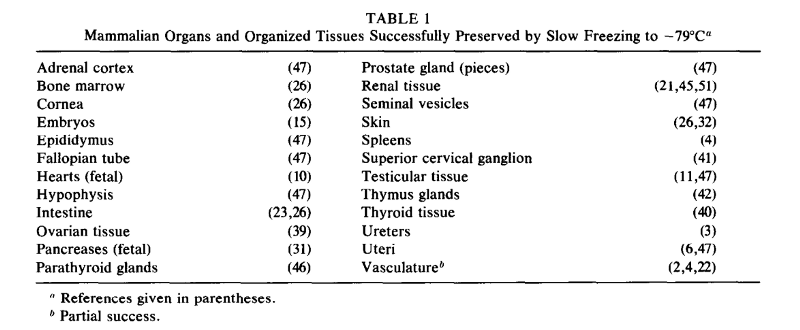
Among other problems of cooling, denaturation (deployment) of proteins can be noted, but, fortunately, with a decrease in temperature, this denaturation is most often reversible. Unlike raising - the boiled egg cannot be boiled back. At the same time, since all chemical reactions (and therefore biological processes) slow down at low temperatures, and then stop altogether, the harm from such denaturation is minimal for frozen organisms.
Well, at the end of the list of problems it is worth mentioning thermal macrocracks, especially often formed when the temperature drops below -140 ° C. As far as they are fraught with complications, the question is still open, but there are opinions that their danger is low. Also, there are new technologies on the horizon of how these cracks could have been avoided - for example, by not allowing the cryopatient's body temperature to fall below -140 ° C:
Systems for Intermediate Temperature Storage for Fracture Reduction and Avoidance
Cryonics, 3rd Quarter 2011 See also the Chronology ...
Patent US7278278 - Cryogenic storage system
This invention provides devices and methods for the storage of biological material. Devices of the ...
Patent US7299641 - Cryogenic Storage System with improved temperature control
A cryogenic refrigerant is provided. The cryogenic storage system ...
Let's move from theory to practice and look at the experimental data - when scientists tried to freeze those who do not like to do it themselves. People, for example. But first, take a look at the animals.
Various insects successfully froze and thawed 100 years ago, this will surprise no one. Therefore, I will mention just a few examples.
Many have heard about the indestructibility of Tardighoda ( Tardigrada ) - they were sent into space and were frozen to -196 ° C without any preparation or cryoprotectants. And nothing, they were defrosted and lived on.
Nematode worms are a favorite model organism of biologists. They were honed vitrification technology, giving 100% survival. Moreover, it was also shown that their long-term memory is preserved after several days of freezing at -80 ° C! What is very important to demonstrate the preservation of the individual after freezing
In other experiments, the Alaskan beetle ( Upis ceramboides ) was successfully thawed after cooling to -75 ° C - and this is a much larger insect:
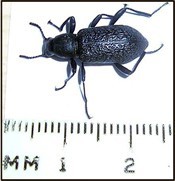
One of the first important experiments on the freezing of mammals was carried out as far back as 1951 (and the very first were still in 1912 — when Porfiry Bakhmetiev introduced into anabiosis bats - this is the original of his 1912 (!) Article of the year). In these studies, rats were frozen without any cryoprotectants, and it was found that by lowering the temperature to 0 ° C (but not lower), almost 100% survival can be achieved. Moreover, some rats were frozen and thawed repeatedly - some as much as 10 times. The researchers also found that with fast freezing ( supercooling ), when the water does not have time to turn into ice, some rats can survive even after cooling down to -3 ° C:
In the same 1950s, other researchers froze hamsters, bringing their temperature to -1 ° C, and varied the freezing times to determine how much ice their bodies could tolerate. In these experiments, it was shown that as much as 60% of the water in the brain can turn into ice without visible behavioral consequences for animals after defrosting. ( Source , Source ).
By the way, in the studies of 1954–6, some hamsters survived even after cooling below -3 ° C. Some of them were cooled to body temperature between -3 ° C and -5.5 ° C, at which they were held for 16 to 38 minutes, and then quickly heated and restored, after which these hamsters lived for many more months without any problems with health:
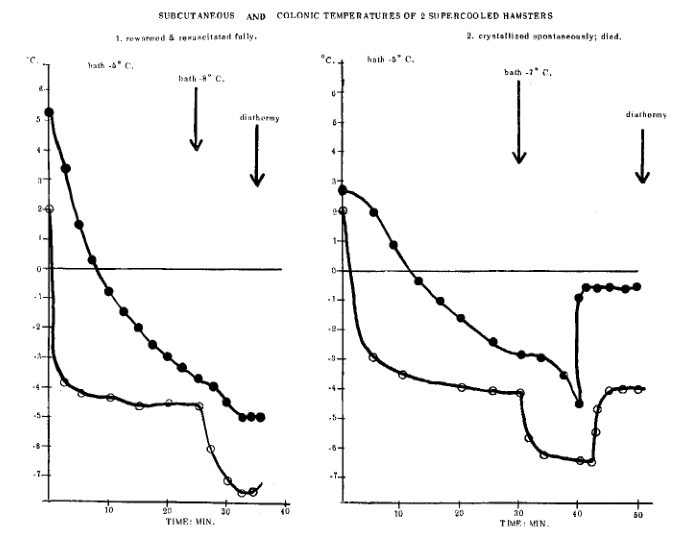
Experiments with primates ( Galago crassicaudatus ) in the same 1950s were less successful. After freezing below 0 ° C (without cryoprotectants!), Primates first recovered, but then did not live for more than a day, dying either from pulmonary edema or intraperitoneal hemorrhage (caused by gastric juice, diffused from the bile glands or the stomach, and eaten away by abdominal fabrics). But the cooling schedules are quite impressive:
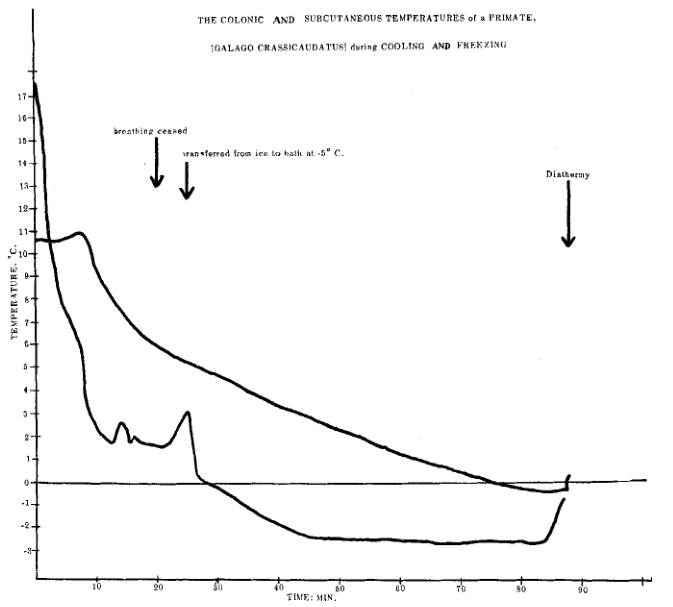
Twenty-first century, too, have something to brag about. For a long time, the kidney remained the most difficult organ for cryopreservation - after defrosting, its function, alas, was critically violated. But in the early 2000s, the star of cryobiology, Gregory Fey, was able to take this line. By the way, it is rather symbolic that these works were made under the auspices of 21st Century Medicine.
In his experiments, Fahey removed one kidney from a rabbit, vitrified it to various temperatures, then thawed it and transplanted it back to the donor, after which it removed the second, healthy kidney. In 2003, Fahey was able to find a successful combination of cryoprotectants and a rather complex vitrification protocol that allowed him to successfully cool his kidneys to -22 ° C or even -45 ° C , and for two rabbits he was able to cool to as much as -130 ° C. However, more than 30 rabbits were successfully cooled to -22 ° C or -45 ° C, and of the two whose kidneys were cooled to -130 ° C, one died 9 days after the return transplant, and the second lived 48 days after which was scored for histological analysis.
By the way, this famous photo, vividly demonstrating the difference between a frozen and vitrified kidney, originates from an even earlier work by Feija - 1984 (!) Of the year:

Compared with the kidney, the brain is considered by cryobiologists to be far more adapted to cryopreservation. In whole or in part, it was possible to freeze it or vitify it without structural damage repeatedly. Moreover, in several works, the preservation of its various functions was demonstrated.
The most intriguing were and remain the experiments of the Japanese cryobiologist Isamu Suda. In 1966, the Court issued an article where he stated that he was able to detect electrical activity in cat brains after months of freezing at -20 ° C. Here is a squeeze of EEG from his work:

This is how the perfusion device looked like:

In 1974, the Court published its next , much more detailed work. In it, he, in particular, showed that even after 7 years of freezing at -20 ° C, the cat's brain showed synchronized electrical activity for several hours after defrosting, although of a worse quality than that of the brain, which had not been frozen. He also compared the EEG of a “fresh” brain and brain after 5 days of storage at –20 ° C; their performance was almost identical.
Here it is necessary to mention that so far no one has managed to reproduce the results of the Courts, although no one has tried to repeat in detail, step by step, all his methodology. Before retirement, the Court handed over all of its materials and laboratory journals to Gregory Fey, and he did not see any signs of falsification in them.
At the same time, Fahey also conducted various experiments on the selection of the optimal protocol for brain cryopreservation. And in 2016, he, together with colleagues from 21st Century Medicine, received the Small Mammal Brain Preservation Prize for the technology of preserving the histological structure of the rabbit brain. True, this brain was irreversibly processed (or fixed ) by aldehyde, which makes its biological functioning impossible after defrosting, but this does not negate the importance of this achievement for cryobiology.
Long before that, back in 2006, Fahey, together with Yury Pichugin, demonstrated that with proper selection of a cryoprotectant and vitrification protocol, rat brain sections are perfectly preserved even after -130 ° C: more than 90% of the samples retained their structure and even the potential for electrical activity (measured by the proportion of sodium and potassium ions compared with the control).
And in 2007, 21st Century Medicine announced that it was able to confirm the preservation of basic electrical “learning abilities” (long-term potentiation, long-term potentiation , LTP) of neurons in rabbit brain sections after vitrification, and then published these results in 2012 The book "Cryopreservation of Precision Cut Tissue Slices":
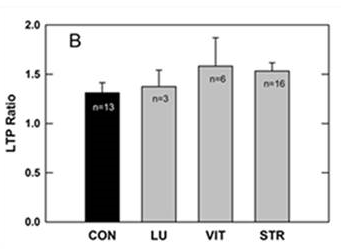
Figure 6B. This is a form of neurophysiological “memory” response. excitatory post-synaptic field potentials at the Schaffer Collision-CA1 dendrite junction) Control response to about 30% above the baseline response amplitude (LTP ratio of 1.3) in response to prior “training”. After loading and unloading of VM3 (LU); after loading of VM3, vitrification, rewarming, and unloading of VM3 (VIT); and the storage of water temperature (STR); each values represent the number of independent bars. Previously unpublished data of 21st Century Medicine.
The studies of Fahey and Pichugin helped to select the optimal composition of the cryoprotectant and the perfusion protocol that are used today in cryopatients. By the way, anyone can take a look at the brain of some of these cryopatients, since the wonders of computed tomography and YouTube made it possible:
In this section, we see that there is practically no ice in the patient’s frozen brain, and he is well saturated with a cryoprotectant:
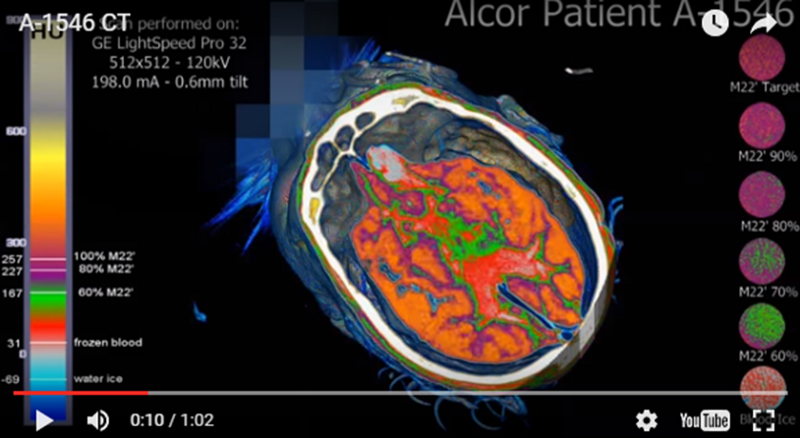
Here are a couple of patients:
Returning to the experiments of the Courts - in 2016, Canadian scientists published even more amazing (if not to say implausible) results. They were able to detect electrical activity in human brains that have been stored for more than 20 years in formalin:
When is the brain dead? Living-Like Electrophysiological Responses and Photon Emissions from ...
The structure of the post-mortem human brain can be preserved by Once ... journals.plos.org
Formalin is a well-known tissue fixer, widely used in biology for storing various samples, since it irreversibly fixes the state of tissues at the cellular level. Roughly speaking, it “sticks together” the cells, turning them into jelly. Nobody could expect that the tissues so treated could retain at least some biological function. If only because the formalin-treated cell membranes are destroyed and stop pumping protons, and this is theoretically necessary for the transmission of electrical impulses. Therefore, the results of Canadians, almost all are treated with great skepticism. But at the same time, there is no reason to consider these data as falsifications, so it would be very useful if someone from respected cryobiologists, especially those with experience in brain tissue, tried to reproduce them.
Why are experiments that demonstrate the ability of the brain to restore its functions after a short or long break in its work (even without freezing), so important? Because they show that cryonics can work: after all, almost all neuroscientists agree that long-term memory, and therefore our personality, is encoded in the physical structures of the brain, and not in its electrical activity. Moreover, the brain's electrical activity ceases below + 18 ° C, but this does not bear any negative consequences after the restoration of homeostasis. We see this also in people who have undergone profound hypothermia or brain surgery ( source 1 , source 2 ), and on experimental animals, from nematodes and hamsters to primates.
Moreover, the technology of stopping brain activity with subsequent recovery has been repeatedly validated in dozens of animal experiments, and even already undergoing clinical trials on people in the US - I mean the EPR CAT study on hibernation and cooling patients with gunshot wounds to 10 ° C. Here is a description of the study in PubMed:
Emergency preservation and resuscitation for cardiac arrest from trauma. - PubMed - NCBI
Int J Surg. 2016 Sep; 33 (Pt B): 209–212. doi: 10.1016 / j.ijsu.2015.10.014. Epub 2015 Oct 20. Review
But an article about him in New Yorker:
Can Hypothermia Save Gunshot Victims?
Brandon Littlejohn was shot just after 11 pm on Saturday, April 23, 2011.
Here is another resuscitating physician who uses cooling to recover from a heart attack. By the way, he believes that in the future we will be able to recover patients 12 or even 24 hours after the onset of “clinical death”:
Back from the Dead: Resuscitation Expert Says End Reversible - SPIEGEL ONLINE - International
At some point, everyone's heart will stop. For most, this is when they begin to die. Doctors succeed in very few cases ...
Prior to use in humans, the cooling-free anabiosis technology was tested on our very close relatives - pigs. They pumped out all the blood, replacing it with saline, and lowering their body temperature to 10 ° C. In total, more than 200 pigs underwent this procedure with a successful recovery:
https://www.ncbi.nlm.nih.gov/pubmed/18404056
https://www.ncbi.nlm.nih.gov/pubmed/16456447
https://www.ncbi.nlm.nih.gov/pmc/articles/PMC4166101/
Before pigs, a very similar technology was tested on dogs:
Clinical death of 60–120 mins in dogs using suspended animation ...
Crit Care Med. 2003 May; 31 (5): 1523–31. Research Support, Non-US Gov't; Research Support, US Gov't, Non-PHS
And the star of cryonics, Mike Darwin, was even able to bring the interval of bloodless suspended animation to 5 hours . That is, the dog was completely without blood for 5 hours, and then completely restored, including long-term memory - recognizing familiar people and responding to commands. And it was not an isolated experiment. Together with Jerry Lif, Mike conducted a series of such experiments on “complete bleeding”:
Alcor's Pioneering Total Body Washout Experiments
In 1984, Alcor and Cryovita laboratoraties began to demonstrate that large animals ...
Also in the 80s, a case was described with a cat that recovered after an hour without a heartbeat, and this is without any cooling.
Global cerebro-circulatory arrest recovery
J Neurol Sci. 1987 Feb; 77 (2–3): 305–20.
All these data allow us to believe that even with a delay of several hours between the onset of clinical death and the onset of cryopatient perfusion, the latter has chances for future recovery of brain functions. Firstly, because even without cooling, irreversible changes in the brain begin to occur only after 1–2 hours, and necrosis of neurons begins only after 4–6. And secondly, because the brain is a very plastic organ that can recover from serious damage.
I will give a few examples of such recovery.
For example, US Senator Gabriel Giffords , who was shot through the brain in 2011, and six months later she returned to work in the Senate. On the left photo she is in the hospital, and on the right she jumps with a parachute after several years.

Or here is another case of successful recovery from a shot-through brain - Rachel Barezinski . The bullet went through the whole brain, but Rachel survived and recovered:
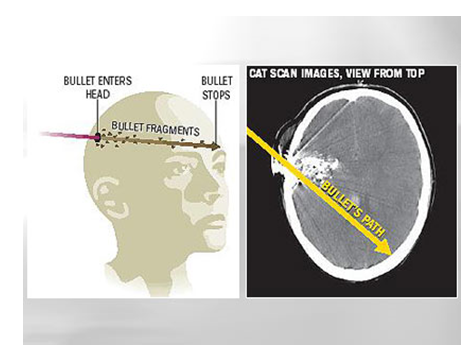
Moreover, some people even remove the whole hemisphere:
Hemispherectomy - Wikipedia
Hemispherectomy is a very rare ... he.wikipedia.org
And some even more:

, . , .. .. , 1930-. , :

— , :
?
, . — . , 10 000 “”, , , . :
Baby born from embryo frozen 20 years ago
Preserving embryos by freezing has become commonplace in fertility treatment to allow women to attempt multiple cycles…
— , 4 8 . . , , , , , , . : , , 70 :
Ovarian tissue cryopreservation and transplantation: scientific implications
After fresh or frozen ovary transplantation, FSH levels return to normal, and menstrual cycles resume by 150 days…
, - — , 0°C. , - - , .
( ):
- Cryonics: Reaching for Tomorrow by Brian Wowk and Michael Darwin
- Scientific Justification of Cryonics Practice by Ben Best
- Low Temperature Biology of Insects by DL Denlinger
- Cryopreservation of Precision Cut Tissue Slices by Gregory M. Fahy, Na Guan, Inge AM de Graaf, Yuanshen Tan, Lenetta Griffin, Geny MM Groothuis. Xenobiotica (2012)
- :
http://www.benbest.com/cryonics/cryonics.html
Source: https://habr.com/ru/post/404019/
All Articles